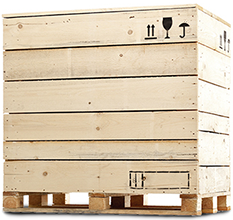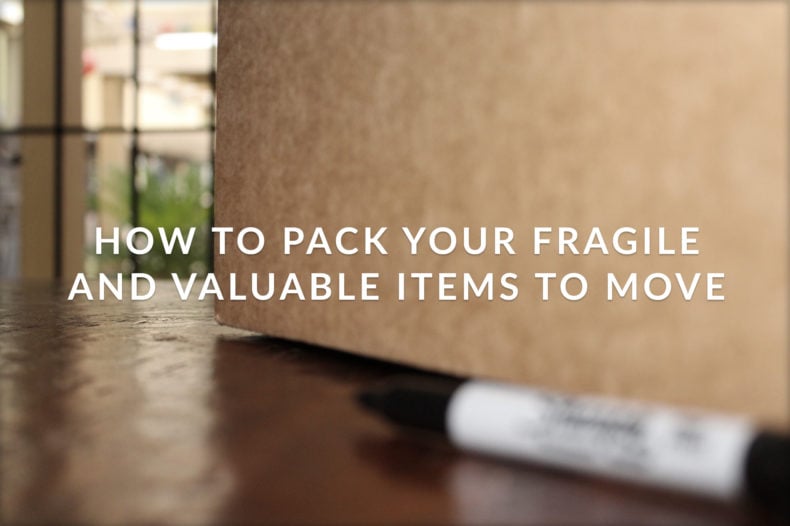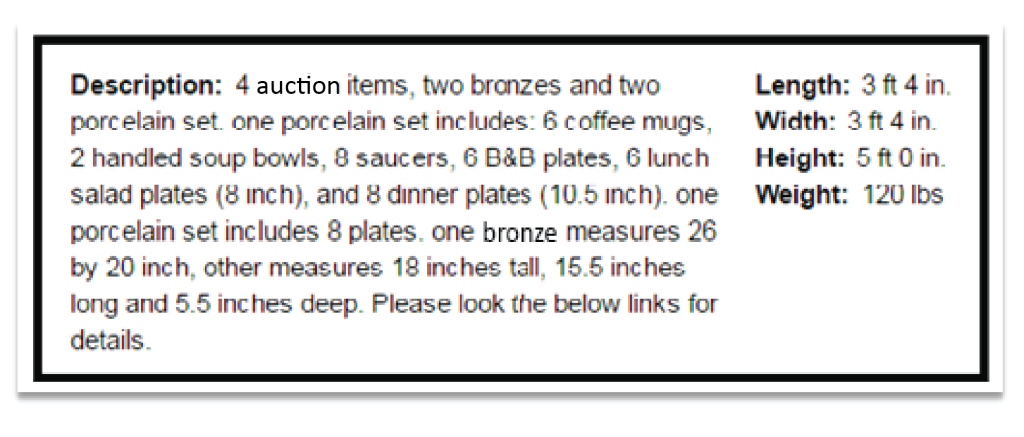You are at the first, and most important, step in making sure your delicate items stay protected throughout your move. Taking the time to properly package and label your fragile items can ensure your breakables arrive in one piece.
The most beneficial thing you can do during the packing process is take your time. It is easy to mess up or forget to wrap something when you’re in a hurry, so plan ahead and set aside a reasonable amount of time to focus on packing your breakables before your moving date. By setting aside the appropriate time to pack and protect your delicate valuables you can help ensure they will arrive safely – just as you packed them.
We suggest starting a month in advance of your move. Take the time to go through your home and set aside all of your valuable crystal, china, mirrors and any other breakables you may have. Plan a separate time to concentrate on properly packing these items and have them ready long before your movers arrive.
Visit our cost to ship fragile or special care items page for an inside look into the fragile shipping process with uShip. Being familiar and comfortable with the fragile shipping process will be a big help when it comes time to choose the moving company best fit for your own needs.
Remember: staying organized throughout this process will be key to properly and efficiently getting all of your valuables packed. Any of the above listed packing materials can be found at Wal-Mart, ULINE, UHAUL, or your local office supply store. It’s also a good idea to check with your moving company, as they will most likely be able to provide any moving equipment you might need.

When it comes to using bubble wrap, remember if you’re moving heavier, oddly shaped, or pointed items it is likely that the bubble wrap will pop during the move. In the case of a long distance move, your item could end up wrapped in plastic paper- with no bubbles left to protect it. Shy away from bubble wrap, if this is the case.
From bubble wrap to the proper boxes, having the right packing materials can be the difference in your breakable items arriving in one, or many pieces.
CHOOSING THE RIGHT BOX FOR PACKING AND SHIPPING FRAGILE ITEMS

Whether you’re searching the internet or standing in the aisle, staring at the multitudes of box choices- we know choosing the right box for the job can be overwhelming; but while it is overwhelming, it is also necessary.
If you choose a box too large, your fragile items then have room to roll around, move about and break during your big move. Choose a box too flimsy and it could break, along with your fragile item(s).
When deciding which box is best for your fragile packing needs- first note the weight of your items. If what you are packing is heavy, you’ll want to choose a box that is double-walled. A double-walled box is about 1/4” thick. This feature provides a more sturdy protect than regular packing and shipping boxes and can stand up to 80-pounds. If you’re packing multiple glass bottles, pick a double-walled box with a partition insert. This will help hold each glass in place and provide padding between them.
Another thing to consider when choosing the best fit box is stacking. If you will be stacking these boxes (fragile or not) for the move, you will want to choose a double wall box. The extra strength it provides will be worth it when your items arrive at their new home un-squished.
HOW TO PACK YOUR HOUSEHOLD BREAKABLES
Start by separating your fragile items into categories, with like pieces together. When wrapping dishware, each piece should be done based on its structure. This means that plates should be packed differently than glasses, bowls, etc. Be sure to take your time and properly label each box with its contents, a “fragile” tag and its destination room in your new home. We recommend using old t-shirts or towels to pad the inside of the box, as opposed to bubble wrap or newspaper alone.
HOW TO PACK PLATES
Wrap each plate in bubble wrap, secure with a piece of scotch tape, and store them vertically. By storing your plates vertically inside the box, you reduce surface area and thus risk of breakage during transport. For finer china we recommend going an extra step and placing a piece of pliable cardboard or cushion foam between each plate and on the top and bottom of your box, again stacking them vertically. Fill empty space in the box with crumpled newspaper and/or an old t-shirt to reduce any room for them to move around. DO NOT over pack any boxes! That is a sure way to damage your breakables.

HOW TO PACK GLASSES AND FINE GLASSWARE
When wrapping glasses, first wrap each in newspaper- tucking the paper inside the glass as well. Then secure with tape. Since glassware tends to be smaller, but heavier when stacked, your best bet is to use a small or medium double wall box for packing. It’s okay to layer the box, just make sure the heaviest glasses are on the bottom and the lighter glasses are on the top while using a piece of pliable cardboard in between each layer. Be sure to label which side is the top of the box.

 HOW TO PACK MIRRORS AND LARGE GLASS ITEMS
HOW TO PACK MIRRORS AND LARGE GLASS ITEMS
When shipping mirrors or sheet glass (picture frames or windows, etc.) start by placing painter’s tape in the middle of the glass, in the form of a star, expanding to the edges. This will prevent the glass from shifting and help absorb any vibrations that may crack the glass. Protect the corners of the mirror or sheet glass with foam frame protectors and wrap the whole thing in bubble wrap.
For smaller mirrors or glass items, we recommend using a mirror corrugated box. This type of box is specially designed to protect your mirror during transportation. A mirror corrugated box can be found at ULINE.com or check with your chosen moving company to see what they can offer.
If you are storing multiple pieces together be sure to group them by sizes. Larger mirrors should be stored together and away from any smaller, more fragile pieces. Protect each piece from the other by using an extra layer of crumpled up newspaper, bubble wrap, or foam sheets in-between the pieces. However, if you are packaging a highly valuable piece of art (such as a priceless family heirloom) or a mirror, we highly recommend crating the piece for added protection.
CRATING

The cost for crating will not be included in your moving quote. However, should you choose to crate your item it is likely the moving company will be able to do so for you. We recommend asking about cratin
g options from the beginning. The average price starts around $70 to crate a single piece. Because each crate is built specially for the item in question, cost will vary.
HOW TO PACK VASES AND FRAGILE CERAMICS
 When it comes to vases you will again want to use smaller boxes. Remember, less is more when working with fragile items.
When it comes to vases you will again want to use smaller boxes. Remember, less is more when working with fragile items.
Wrap the vase in newspaper and stuff the middle with crumpled up paper to reduce any friction during the move. Next, wrap the whole thing in bubble wrap and secure with tape. Pad the box with old t-shirts or towels before inserting the vase.
Smaller pieces may be packaged together, storing them with their heavy ends down and using pliable cardboard or cushion foam between each piece. If you are working with a larger vase we recommend packing it alone in a double wall box, surrounded by crumpled up newspaper and towels to fill any extra space.
HOW TO PACK ABNORMALLY SHAPED PIECES
For other abnormally shaped pieces, wrap them in newspaper, tape securely and then re-wrap in bubble wrap. Make sure all edges and angles are protected. Use foam coverings for any points or delicate edges and never over-pack your boxes. If you are stacking pieces, use pliable cardboard in between layers and opt for double wall boxes. Fill any extra room with crumpled paper and/or bubble wrap when necessary.
Remember, when packing fragile items, do not over pack but do not leave empty space in the box for your items to move around. The solution to this problem will be to use your crumpled newspaper and/or bubble wrap as filling. You want your items to be snug and secure throughout transport, so don’t be shy with the bubble wrap or tape. Use all you need to feel confident. Better safe than sorry.
Follow these packing steps and you can be confident that your items will show up to their new home in one piece.
No matter what you are packing, always make sure to label it as ‘fragile’ and designate the top of the box when needed. We also recommend noting the room that the box should go into at your new home.
HOW TO PACK AND SHIP MUSICAL INSTRUMENTS
When it comes to packing musical instruments you’ll have to consider other techniques. Since they tend to be larger and more oddly-shaped than everyday fragile household goods (like glassware or china), you should follow a few extra steps to protect them. You can even get a little creative.
Being that instruments are sensitive items, you’ll need to make sure they are prepared to go through any change in temperature, humidity and/or air pressure. If you are transporting a stringed-instrument, loosen the strings. Not so much that they are flopping around, but just enough to account for any environment changes. Forgetting this step could cause your instrument to crack or your strings to snap.
With bows, do the same- loosen bow hairs to prevent snapping.
Next, think about your instrument’s journey. Will the ride be bumpy? It’s likely that the answer to this question is going to be yes. This being so, you’ll want to make sure your instrument is packed snugly in its case. Adding extra padding will reduce any risk of movement and ensure the instrument stays in one place, no matter how rough the road ahead.
We recommend using socks or old t-shirts for this purpose. If you have any foam at your disposal, it may also be used. By wrapping and padding your instrument you are decreasing friction and closing any open surface area between the case and the musical instrument, reducing room for movement.

Note: Do Not force the zipper on your case shut. If it is too tight, try removing one or two of the t-shirts instead.
Finally, make sure that anyone transporting the instrument knows exactly what is in the case and how to properly handle it. We recommend purchasing ‘fragile’ tags for your instrument. You can attach the tag to your case, reminding anyone that moves your instrument that it should be handled with care. It might also be a good idea to include a “this side up” sort of note on the top of your case, so movers don’t set your violin or guitar on its strings.
Most importantly, make sure your mover is familiar with the transportation of instruments, as they require a little extra attention to detail. If your instrument is wooden, let your mover know that it should not be stored in an enclosed trailer for any extended period of time. Transporting a wooden instrument in an enclosed trailer can cause warping, open seams or other serious problems that will require expensive repair.
Double check that your musical instruments are covered under your insurance policy and consider getting each appraised before your move.
WHY YOU SHOULD CONSIDER WHITE GLOVE MOVERS
By choosing a white glove moving company, you are investing in the safe arrival of your delicate valuables. A white glove moving company will take care of everything from start to finish, leaving you with more time to focus on crossing off other important items on that moving checklist of yours.
If you haven’t already complied your own moving checklist or home inventory list, download our FREE Moving Checklist and Moving Inventory Templates to help you get started!
White glove movers are ideal to consider when your move includes: valuable antiques, pieces requiring assembly, or fragile items that require special attention and care. These specialized movers will make handling your fragile items with care a priority, giving you a much needed peace of mind during your move. White glove moving companies provide detailed care and assistance in properly packaging, carefully transporting and properly unpacking and assembling your valuable items.
If you don’t have the time to properly package your valuables with the proper attention and care, choose a white glove moving service for your move. It’s an investment worth making.
CHOOSING A MOVING COMPANY YOU CAN TRUST

Research can make all the difference in the outcome of your move. We recommend that all of our shipping customers take the time to do their due diligence in researching each prospective moving company. Before you lock yourself into an agreement with one mover you‘ll want to know you can trust and rely on them.
Read through prospective movers’ customer reviews. Look over their carrier profile and their moving history.
A good moving company will meet the following criteria:
- A good reputation with uShip customers
- Excellent communications skills (call before delivery and can be reached during and after transit)
- A safe driving history
- A registered DOT number
- Willing to work with you on your moving dates
- Provides written proof of insurance, along with appropriate bill of lading
Check out our guide on how to choose the best moving company according to your moving needs for further insight into this step of the listing process.
You want to be able to have full-confidence in the movers you hire. Doing so will ensure that you get the best moving experience possible and give you a piece of mind during the aspects of the move that aren’t in your control.
Visit the U.S. Department of Transportation’s SAFER system where you can see what any non-uShip customers have said about your prospective moving company; or call the DOT at 1-888-368-7238 and find out if there are any complaints against the company. If you do not know your company’s DOT number, search for their Company Snapshot with the DOT, using the company name. A Company Snapshot give you an inside look at the company’s history and records with the DOT. All information is open to the public and easily accessible. We encourage you to complete this extra step during your research process.
CHOOSING MOVING INSURANCE
Moving insurance is a must-have for any move, big or small. You do not want to be left empty handed in the event that something goes wrong with your valuables during the move.
While all moving companies are required to carry a minimum amount of insurance in accordance with the Federal Motor Carrier Safety Administration, most companies will offer extra insurance coverage which you can choose based on your move. However, we always recommend taking the extra coverage.
You have options when it comes to insurance coverage. Be sure to check with your specific moving company to see what they offer in terms of insurance. Coverage will be based on one of three things: total weight of your belongings, total replacement value of your belongings or the assessed value of your belongings.
MOVING INSURANCE TERMS
Replacement Value – The amount that a moving company would have to pay to replace an item at the present time, according to its current worth.
Market Value – The amount your item would sell for on the open market.
Full Value Protection – The moving company is responsible for the replacement of your entire shipment at full value. This form of coverage is subject to higher deductibles and levels of liability based on the moving company’s standards.
Released Value – Assigns a reimbursement price to each item on a per pound scale. The FMCSA requires moving companies to insure between $0.30 and $0.60 per pound.
Valuation – The designated dollar value of your household move, determined by the insurance adjuster.
High Value Item – An item that has a value exceeding $100 per pound.
Certificate of Insurance – Written proof of teh detailed coverage of your household items.
Bill of Lading – Written proof of contract for your move and the receipt for your household goods.
Home Inventory – An itemized list of all the items in your home, including photos and receipts.
In the case that the coverage you are offered is on a price per pound scale, or Released Value, you want to make sure you know exactly how much you are covered for per pound. Moving companies are required by the FMCSA to provide coverage for no less than $0.30 and more than $0.60 per pound, per item. This kind of coverage is the least desirable. Under Released Value coverage, if your coverage is $0.60 per pound and a mover drops your brand new 10-pound turn-of-the-century vase, you’re look at a $6.00 total reimbursement value for that priceless vase.
There is no extra charge for Release Value coverage. It is required by the FMCSA, but cases like we described are the reason we recommend obtaining extra coverage from your own source. Check with your home owner’s or renter’s insurance policy holder and see what they have you covered for in terms of moving.
As always, make sure your chosen moving company provides you with written proof of insurance before the move. Remember your proof of insurance is a separate certificate. While both necessary, do not accept a bill of lading as proof of insurance, these are two separate things. You will want to have both proof of insurance and bill of lading printed and in your hands before the move begins.
Sadly, there is no such thing as sentimental replacement value. It is imperative that you do your best research and preparation when it comes time to choose the right moving company and insurance. Do this and you won’t be left empty handed or under-protected in the case something goes wrong.
If you have more in-depth questions about moving insurance, or what is required from your moving company vs. what is not, visit the FMCSA Understanding Valuation and Insurance Options or check out their tips on protecting your move.
LISTING YOUR MOVE ON uShip
Along with properly packaging your fragile items and fully researching your moving company and insurance coverage options, building the best listing you can for your move is key.
We recommend completing a full inventory of your home prior to writing up your listing. Gather as much detailed information as you can about the items in your home that are to be moved. By doing so you will be able to create the best and most complete listing in our marketplace. An ideal complete listing will include photographs of items, measurements (weight and dimensions) and a detailed description and note any special moving requirements.
Below is an example of a live, detailed listing on the uShip marketplace:
The shipping customer in this case included a very detailed description of their mixed items. Specific measurements for the items individually, as well as the items’ dimensions when palletized together.
The purpose of creating a detailed, complete listing is to help ensure that you only receive quotes from the most qualified moving companies. These are moving companies that are equipped and prepared to handle your specific moving needs. It also ensures that the quotes you do receive will be an accurate portrayal of what your move will cost in the end, reducing the risk of missing permits or extra costs on moving day.
RESOURCES
This article was built with help and advice from the following:




